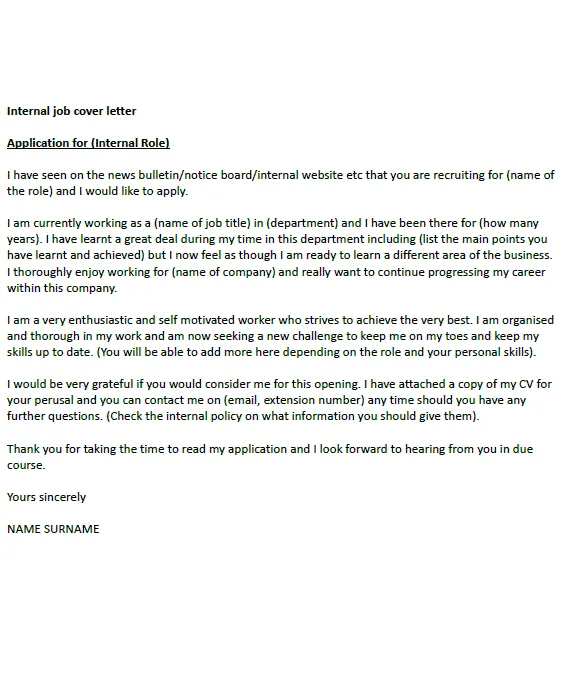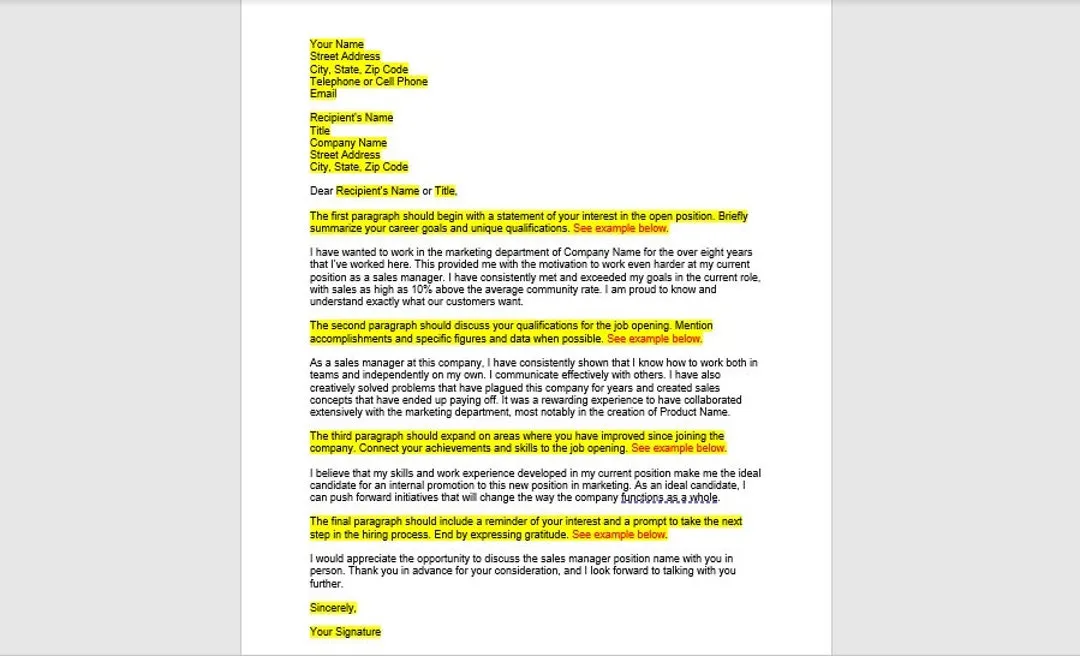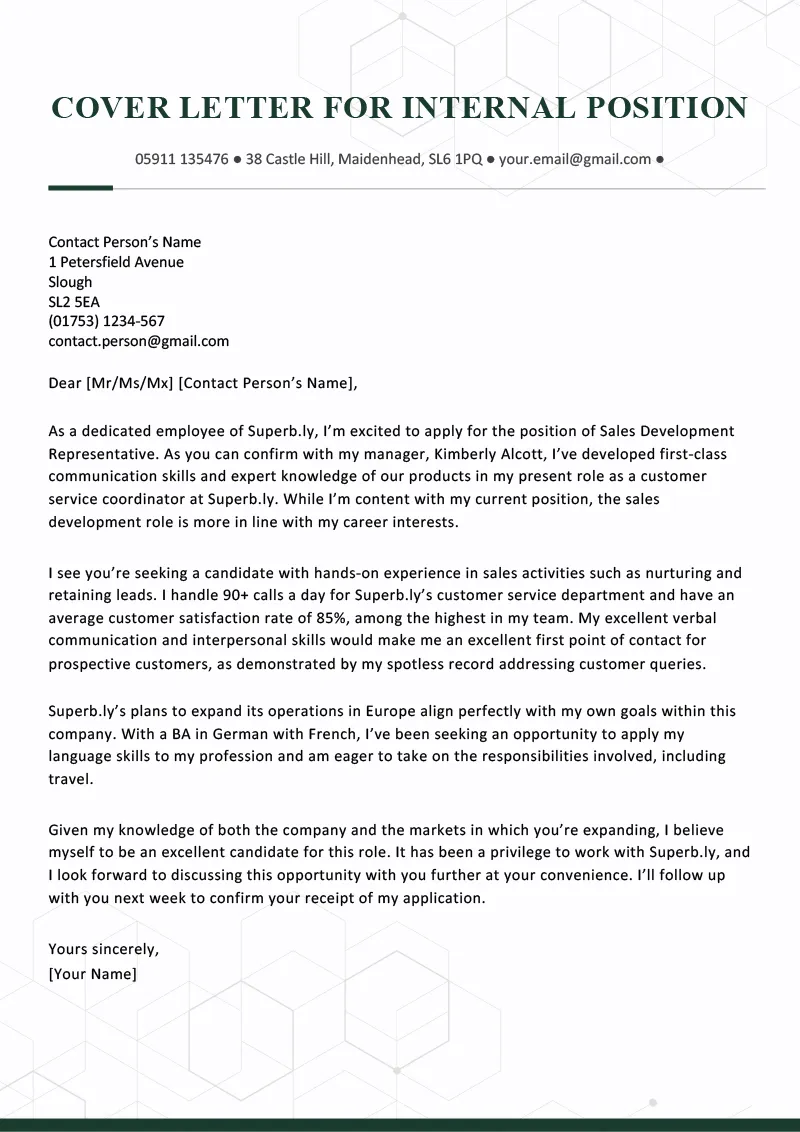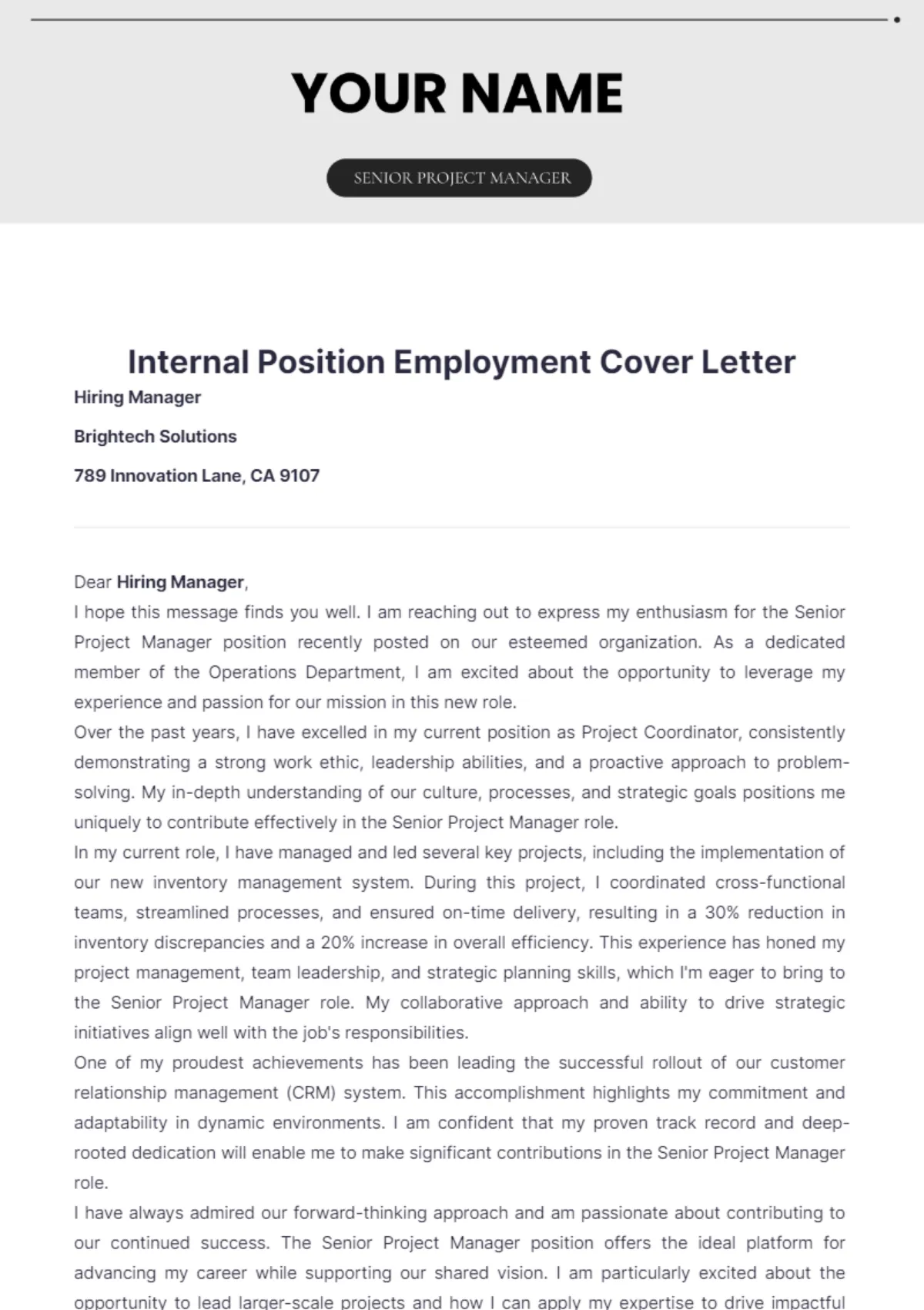Understanding Internal Positions Cover Letter
Applying for an internal position requires a strategic approach, and a well-crafted cover letter is your key to success. Unlike external applications, you’re already familiar with the company culture, but you still need to demonstrate why you’re the best fit for the role. Your cover letter is your opportunity to showcase your achievements, highlight your company knowledge, and articulate your passion for the new position. It’s not just a formality; it’s a crucial tool for making a strong impression on the hiring manager and increasing your chances of landing the job. By focusing on your relevant skills, experience, and contributions, you can position yourself as a top contender and make a compelling case for your promotion or transfer. This guide will help you navigate the process and create a cover letter that gets you noticed.
Researching the Internal Role
Before you start writing, thorough research is essential. Understand the responsibilities, required skills, and expectations of the new role. Review the job description carefully, paying close attention to the specific requirements and preferred qualifications. Identify the key challenges and opportunities associated with the position. This research will enable you to tailor your cover letter to directly address the hiring manager’s needs and demonstrate your understanding of the role. Look for any internal resources such as job postings, employee handbooks, or internal communications that can provide additional insight into the position. If possible, speak with individuals who currently hold similar roles or have worked in the department to gain a deeper understanding of the work environment and expectations. Effective research lays the foundation for a targeted and persuasive cover letter.
Key Information Needed

Your cover letter should provide essential information that directly addresses the hiring manager’s needs. Start by clearly stating the position you are applying for and where you saw the posting. Briefly introduce yourself and highlight your current role and tenure within the company. Then, focus on showcasing your relevant skills, experience, and accomplishments. Provide specific examples that demonstrate your ability to perform the job duties and contribute to the company’s goals. Explain why you are interested in the position and what you hope to achieve in the role. Show your understanding of the company’s values and how your personal values align with those of the organization. Be concise and focused, ensuring that your letter provides a clear and compelling overview of your qualifications and suitability for the position.
Highlighting Your Achievements
One of the most crucial aspects of your cover letter is highlighting your achievements. Instead of simply listing your responsibilities, focus on the positive outcomes and results you have achieved in your current and past roles. Use the STAR method (Situation, Task, Action, Result) to structure your examples. Describe the situation you were in, the task you were assigned, the actions you took, and the positive results you achieved. Quantify your accomplishments whenever possible, using metrics and data to demonstrate your impact. Focus on achievements that are relevant to the new position, showcasing how your skills and experiences align with the job requirements. By highlighting your achievements, you’ll demonstrate your value to the company and make a compelling case for why you are the best candidate for the role.
Quantify Your Accomplishments
Numbers speak louder than words. To make your achievements even more impactful, quantify them with specific data and metrics. Instead of saying ‘Improved customer satisfaction,’ say ‘Increased customer satisfaction scores by 15%.’ Instead of stating ‘Managed social media,’ say ‘Grew social media followers by 30% in six months, leading to a 10% increase in website traffic.’ Use percentages, dollar amounts, and other relevant figures to demonstrate your impact and provide tangible evidence of your successes. This helps the hiring manager understand the scope and significance of your achievements, making your cover letter more persuasive and memorable. Quantifying your accomplishments shows that you not only excel in your role but also understand how your contributions impact the company’s bottom line.
Demonstrating Your Company Knowledge

When applying for an internal position, you have an advantage over external candidates, as you already have knowledge of the company. Showcase this knowledge in your cover letter. Mention specific company initiatives, projects, or goals that resonate with you. Demonstrate your understanding of the company’s values, culture, and mission. Discuss how your experience within the company has prepared you for the new role and how you can contribute to its success. If possible, mention specific teams, departments, or individuals you have worked with and how you collaborate effectively. Showing that you are well-informed about the company’s operations and strategic direction, you prove you are a valuable asset and are invested in its future.
Showcasing Your Cultural Fit
Demonstrating your cultural fit is just as important as highlighting your skills and experience. Briefly discuss how your values align with the company’s values. Provide examples of how you embody the company culture in your current role. Mention your ability to work effectively with colleagues, contribute to team goals, and embrace the company’s work environment. Highlight your enthusiasm for the company’s mission and your desire to contribute to its success. If the job description mentions specific personality traits or values that are important to the role, incorporate those into your cover letter. Cultural fit is crucial, as it affects collaboration, productivity, and overall job satisfaction. Demonstrate that you’re not only qualified for the job but also a great fit for the company’s work environment.
Tailoring Your Cover Letter
Never use a generic cover letter. Tailor each cover letter to the specific role and company you are applying for. This involves carefully reviewing the job description and identifying the key skills, experiences, and qualifications that are required. Then, adapt your cover letter to directly address these requirements. Highlight the aspects of your experience that are most relevant to the position, and provide specific examples of how you have demonstrated those skills in the past. Customize your letter to reflect your understanding of the company’s values and culture. By tailoring your cover letter, you demonstrate to the hiring manager that you have taken the time to understand the role and the company, showing that you are genuinely interested in the opportunity.
Customizing for the Specific Role

Customizing your cover letter for the specific role you are applying for is essential. Begin by reviewing the job description and identifying the most important requirements and qualifications. Use the job description as a guide to structure your letter, emphasizing the skills and experiences that directly align with the role. If the job description emphasizes teamwork, provide examples of successful team collaborations. If the role requires strong communication skills, showcase your ability to communicate effectively. Make sure your cover letter directly addresses the key challenges and responsibilities outlined in the job description. Demonstrating that you’ve done your research and understand what the role entails will significantly increase your chances of landing the job.
Formatting Your Cover Letter
The formatting of your cover letter can significantly impact its readability and professionalism. Use a clean, easy-to-read font, such as Arial or Times New Roman, with a font size between 10 and 12 points. Maintain consistent formatting throughout the document. Use clear headings and subheadings to organize your content and make it easy for the hiring manager to scan the letter. Use bullet points to highlight key accomplishments and skills. Keep your paragraphs concise and to the point. Ensure the layout is visually appealing, with ample white space between paragraphs. A well-formatted cover letter demonstrates attention to detail and a commitment to professionalism, making a positive impression on the hiring manager.
Proper Structure and Layout
A well-structured cover letter follows a standard format, including an introduction, body paragraphs, and a conclusion. Start with a professional salutation, such as ‘Dear [Hiring Manager name]’ or ‘Dear [Department name]’. In the introduction, state the position you are applying for and briefly mention where you saw the job posting. The body paragraphs should highlight your relevant skills, experience, and achievements, providing specific examples to support your claims. Demonstrate your knowledge of the company and showcase your cultural fit. In the conclusion, express your enthusiasm for the opportunity and reiterate your interest in the position. Include a call to action, such as stating that you are available for an interview and eager to discuss your qualifications further. Finish with a professional closing, such as ‘Sincerely’ or ‘Best regards’, followed by your name.
Including a Strong Call to Action

Your cover letter should include a strong call to action that encourages the hiring manager to take the next step. In the conclusion, clearly state your interest in the position and your availability for an interview. Express your enthusiasm for the opportunity and reiterate your qualifications. You can also include a specific request, such as stating that you are eager to discuss your qualifications further and provide additional information. Make sure your call to action is clear, concise, and persuasive. By including a strong call to action, you will increase the likelihood of the hiring manager reaching out to schedule an interview, bringing you closer to your goal of securing the internal position.
Reviewing and Editing Your Letter
Before submitting your cover letter, thoroughly review and edit it to ensure it is free of errors and that it is well-written. Check for grammatical errors, typos, and spelling mistakes. Ensure that your sentences are clear, concise, and easy to understand. Verify that your content flows logically and that your arguments are well-supported. Proofread your letter multiple times, ideally, at different times, to catch any errors that you may have missed. Consider asking a colleague or friend to review your cover letter for feedback and suggestions. A well-edited and error-free cover letter demonstrates your professionalism and attention to detail, increasing your chances of making a positive impression on the hiring manager.
Proofreading for Errors
Proofreading is the final and most critical step in the cover letter writing process. Errors, no matter how small, can undermine your credibility and reduce your chances of being selected for an interview. Carefully proofread your letter for any grammatical errors, spelling mistakes, and typos. Check for punctuation errors, such as incorrect commas, semicolons, and apostrophes. Make sure your sentences are grammatically correct and that your content flows logically. Read your letter aloud to catch any awkward phrasing or unclear sentences. Consider using grammar and spell-checking software to help identify potential errors. By carefully proofreading your cover letter, you ensure it reflects your attention to detail, professionalism, and commitment to excellence. This is your last chance to make a positive impression on the hiring manager, so make it count.
